
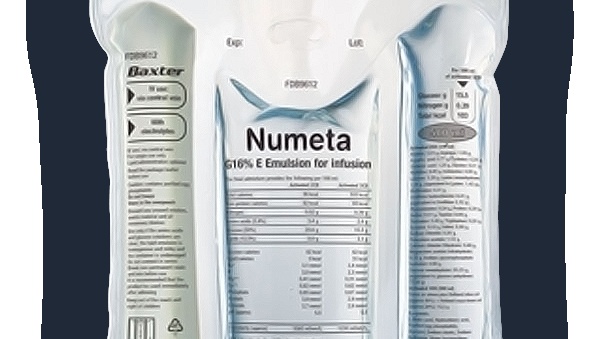
НУМЕТА G13% Эмульсия для инфузий

Спросите врача о рецепте на НУМЕТА G13% Эмульсия для инфузий

Инструкция по применению НУМЕТА G13% Эмульсия для инфузий
Введение
Инструкция: информация для пользователя
NUMETA G13%E эмульсия для перфузии
Прочитайте внимательно всю инструкцию перед началом использования этого лекарства, поскольку она содержит важную информацию для вас.
- Сохраните эту инструкцию, поскольку вам может потребоваться перечитать ее.
- Если у вас есть какие-либо вопросы, проконсультируйтесь с врачом, фармацевтом или медсестрой вашего ребенка.
- Если ваш ребенок испытывает побочные эффекты, проконсультируйтесь с врачом, фармацевтом или медсестрой вашего ребенка, даже если это побочные эффекты, которые не указаны в этой инструкции. См. раздел 4.
Содержание инструкции:
- Что такое Numeta G13%E и для чего она используется
- Что нужно знать до того, как Numeta G13%E будет введена вашему ребенку
- Как будет введена Numeta G13%E
- Возможные побочные эффекты
- Хранение Numeta G13%E
- Содержание упаковки и дополнительная информация
1. Что такое Numeta G13%E и для чего она используется
Numeta G13%E - это эмульсия для специализированного питания, предназначенная для недоношенных новорожденных. Она вводится через трубку, подключенную к вене вашего ребенка, когда он не может съесть все необходимое питание через рот.
Numeta выпускается в виде трехкамерной сумки с тремя отдельными камерами, содержащими:
раствор глюкозы 50%
педиатрический раствор аминокислот 5,9% с электролитами
эмульсию липидов (жиров) 12,5%
В зависимости от потребностей вашего ребенка, две или три этих раствора смешиваются в сумке перед введением их вашему ребенку.
Numeta G13%E должна использоваться только под медицинским наблюдением.
2. Что нужно знать до того, как Numeta G13%E будет введена вашему ребенку
Numeta G13%Eне должна вводиться вашему ребенку в следующих случаях:
С растворами глюкозы и аминокислот/электролитов, смешанными в сумке (“2 в 1”):
- Если ваш ребенок аллергичен к яйцу, сое, арахису или любому из компонентов этого лекарства или упаковки (перечисленных в разделе 6).
- Если организм вашего ребенка имеет проблемы с использованием составных частей белков.
- Если у вашего ребенка высокие концентрации любого из электролитов, входящих в состав Numeta G13%E, в крови.
- Numeta G13%E (или другие растворы, содержащие кальций) не должна вводиться одновременно с антибиотиком цефтриаксоном, даже если используются разные пути перфузии. Существует риск образования частиц в кровотоке новорожденного, которые могут быть смертельными.
- Если у вашего ребенка гипергликемия (чрезвычайно высокие уровни сахара в крови).
С растворами глюкозы, аминокислот/электролитов и липидов, смешанными в сумке (“3 в 1”).
Все ситуации, упомянутые для «2 в 1», плюс следующая:
- Если у вашего ребенка высокий уровень жиров в крови.
Во всех случаях врач решит, следует ли вводить это лекарство вашему ребенку, исходя из факторов, таких как возраст, вес и клиническое состояние. Также будут учитываться результаты всех проведенных исследований.
Предостережения и меры предосторожности
Проконсультируйтесь с врачом или медсестрой вашего ребенка перед введением Numeta G13%E.
Когда она используется у новорожденных и детей младше 2 лет, эмульсия (в сумках и оборудовании для введения) должна быть защищена от воздействия света до окончания введения. Воздействие Numeta G13%E на окружающий свет, особенно после смешивания с олигоэлементами или витаминами, приводит к образованию пероксидов и других продуктов разложения, которые могут быть уменьшены, если продукт защищен от воздействия света.
Аллергические реакции:
Перфузия должна быть немедленно прекращена, если появляются какие-либо признаки или симптомы аллергической реакции (такие как лихорадка, потоотделение, озноб, головная боль, кожная сыпь или затруднение дыхания). Это лекарство содержит соевое масло, которое редко может вызывать реакции гиперчувствительности. В редких случаях было обнаружено, что некоторые люди, аллергичные к белкам арахиса, также аллергичны к белкам сои.
Numeta G13%E содержит глюкозу, полученную из кукурузного крахмала, поэтому она должна использоваться с осторожностью у пациентов с известной аллергией к кукурузе или ее продуктам.
Риск образования частиц с цефтриаксоном (антибиотиком):
Не следует смешивать или вводить антибиотик цефтриаксон одновременно с раствором, содержащим кальций (включая Numeta G13%E), через капельницу в вену.
Ваш врач знает об этом и не будет вводить их одновременно, даже через разные линии или разные места перфузии.
Образование мелких частиц в кровеносных сосудах легких:
Затруднение дыхания также может быть признаком образования мелких частиц, которые закупоривают кровеносные сосуды легких (васкулярные осадки легких). Если ваш ребенок испытывает затруднение дыхания, сообщите об этом врачу или медсестре вашего ребенка. Они решат, какие меры необходимо принять.
Инфекция и сепсис:
Врач будет внимательно наблюдать за вашим ребенком, чтобы обнаружить любые симптомы инфекции. Применение «асептической техники» (техники без микробов) при установке и поддержании катетера, а также при приготовлении питательной смеси, может снизить риск инфекции.
Иногда дети могут развивать инфекции и сепсис (бактерии в крови), когда у них есть трубка, подключенная к вене (центральный венозный катетер). Определенные лекарства и заболевания могут увеличить риск развития инфекции или сепсиса. Пациенты, которым требуется парентеральное питание (питание, вводимое через трубку, подключенную к вене вашего ребенка), более склонны к развитию инфекции из-за своего клинического состояния.
Синдром перегрузки жиров:
Были описаны случаи синдрома перегрузки жиров с подобными продуктами. Снижение или ограничение способности организма удалять жиры, содержащиеся в Numeta G13%E, или передозировка может привести к «синдрому перегрузки жиров» (см. разделы 3 и 4).
Изменения уровней химических веществ в крови:
Врач будет проверять и пересматривать жидкости, химические вещества в крови и другие показатели крови вашего ребенка во время лечения Numeta G13%E. Иногда реабилитация человека, находящегося в состоянии тяжелой дистрофии, может привести к изменениям в уровнях химических веществ в крови, которые могут потребовать коррекции. Также может произойти избыток жидкости в тканях и отек. Рекомендуется начинать парентеральное питание медленно и под наблюдением.
Наблюдение и коррекция
Врач будет внимательно наблюдать за вашим ребенком и корректировать дозу Numeta G13%E в соответствии с индивидуальными потребностями вашего ребенка, особенно если он страдает следующими состояниями:
- Тяжелые посттравматические состояния.
- Тяжелый сахарный диабет.
- Шок.
- Инфаркт миокарда.
- Тяжелая инфекция.
- Определенные типы комы.
Использование с осторожностью:
Numeta G13%E должна использоваться с осторожностью, если ваш ребенок имеет:
- Легочный отек (жидкость в легких) или сердечную недостаточность.
- Тяжелые проблемы с печенью.
- Проблемы с усвоением питательных веществ.
- Высокие уровни сахара.
- Проблемы с почками.
- Тяжелые метаболические расстройства (когда организм не может расщеплять вещества нормально).
- Расстройства свертываемости крови.
Уровни жидкости в организме вашего ребенка, показатели анализа крови и/или показатели печени будут тщательно контролироваться.
Существует мало данных об использовании этого лекарства у детей, родившихся преждевременно, с gestационным возрастом менее 28 недель.
Использование Numeta G13%E с другими лекарствами
Сообщите врачу, если ваш ребенок принимает или использовал, недавно принимал или использовал, или может потребовать принимать или использовать любое другое лекарство.
Numeta G13%Eне должна вводиться одновременно с:
- цефтриаксоном(антибиотиком) даже через отдельные пути перфузии, из-за риска образования частиц.
- кровьючерез один и тот же путь перфузии из-за риска псевдоагглютинации (эритроциты склеиваются)
- ампициллином, фосфениотином и фуросемидомчерез один и тот же путь перфузии, поскольку существует риск образования частиц.
Кумарин и варфарин (антикоагулянты)
Врач будет внимательно наблюдать за вашим ребенком, если он принимает кумарин или варфарин. Эти лекарства являются антикоагулянтами, используемыми для предотвращения свертывания крови. Соевое и оливковое масло содержат витамин K1 естественным образом. Витамин K1 может влиять на действие лекарств, таких как кумарин и варфарин.
Лабораторные исследования
Липиды, входящие в состав этой эмульсии, могут влиять на результаты определенных лабораторных исследований. Лабораторные исследования можно проводить через 5-6 часов после введения липидов или если липиды не вводятся.
Взаимодействие Numeta с лекарствами, которые могут влиять на уровни/метаболизм калия:
Numeta G13%E содержит калий. Высокие уровни калия в крови могут привести к аномальному сердечному ритму. Необходимо проявлять особую осторожность у пациентов, принимающих диуретики (лекарства, снижающие удержание жидкости), ингибиторы АПФ (лекарства, используемые для лечения повышенного артериального давления) или антагонисты рецептора ангиотензина II (лекарства, используемые для лечения повышенного артериального давления) или иммунодепрессанты (лекарства, которые могут снижать естественные защитные силы организма). Этот тип лекарств может увеличить уровни калия.
3. Как будет введена Numeta G13%E
Вашему ребенку всегда должна вводиться Numeta G13%E точно так, как указал врач. Проконсультируйтесь с врачом, если у вас есть какие-либо вопросы.
Возрастная группа
Numeta G13%E предназначена для удовлетворения потребностей недоношенных новорожденных в питании.
Numeta G13%E может быть не подходящей для некоторых недоношенных детей, поскольку их клиническое состояние может потребовать индивидуальных формул, удовлетворяющих их конкретные потребности в питании. Врач решит, подходит ли это лекарство для вашего ребенка.
Введение
Это лекарство является эмульсией для перфузии. Она вводится через пластиковую трубку, подключенную к вене руки или большой вены груди вашего ребенка.
Врач может решить не вводить липиды вашему ребенку. Конструкция сумки Numeta G13%E позволяет разорвать только непостоянный шов между камерами аминокислот/электролитов и глюкозы, если это необходимо. Шов между камерами аминокислот и липидов остается целым в этом случае. Содержимое сумки можно перфузировать без липидов.
Когда она используется у новорожденных и детей младше 2 лет, эмульсия (в сумках и оборудовании для введения) должна быть защищена от воздействия света до окончания введения (см. раздел 2).
Дозировка и продолжительность лечения
Врач решит, какая доза необходима ребенку, и как долго будет вводиться. Дозировка зависит от потребностей вашего ребенка в питании и основана на весе, медицинском состоянии и способности организма вашего ребенка усваивать и абсорбировать компоненты Numeta G13%E. Также могут вводиться дополнительные белки или питание через рот или кишечник.
Если вашему ребенку введено больше Numeta G13%E, чем необходимо
В случае передозировки или случайного приема проконсультируйтесь с Центром токсикологической информации. Телефон 915.620.420
Симптомы
Получение слишком большого количества лекарства или слишком быстрое введение может привести к:
- Тошноте (чувству недомогания).
- Рвоте.
- Ознобу.
- Электролитным нарушениям (неправильным количествам электролитов в крови).
- Признакам гиперволемии (увеличению объема циркулирующей крови, слишком много жидкости в кровеносных сосудах).
- Ацидозу (повышению кислотности крови).
В этих случаях перфузия должна быть немедленно прекращена. Врач решит, необходимы ли другие действия.
Передозировка жиров, содержащихся в Numeta G13%E, может привести к «синдрому перегрузки жиров», который обычно обратим, когда перфузия прекращается. У новорожденных (неонатов) и маленьких детей синдром перегрузки жиров ассоциируется с респираторными расстройствами, которые приводят к снижению уровня кислорода в организме (затруднение дыхания) и состояниями, которые приводят к увеличению кислотности крови (ацидозу).
Чтобы избежать этих реакций, врач будет регулярно наблюдать за состоянием вашего ребенка и анализировать его показатели крови во время лечения.
4. Возможные побочные эффекты
Как и все лекарства, это лекарство может вызывать побочные эффекты, хотя не все дети их испытывают.
Если вы заметите какие-либо изменения в самочувствии вашего ребенка во время лечения или после него, сообщите об этом врачу или медсестре немедленно.
Исследования, которые врач будет проводить у вашего ребенка во время лечения этим лекарством, должны минимизировать риск побочных эффектов.
Если появляются симптомы аллергической реакции, перфузия должна быть прекращена, и необходимо немедленно связаться с врачом. Это может быть серьезно и симптомы могут включать:
- Потоотделение.
- Озноб.
- Головная боль.
- Кожная сыпь.
- Затруднение дыхания.
Другие побочные эффекты, которые были обнаружены, являются:
Частые: могут повлиять до 1 из 10 человек
- Низкий уровень фосфата в крови (гипофосфатемия).
- Высокий уровень сахара в крови (гипергликемия).
- Высокий уровень кальция в крови (гиперкальциемия).
- Высокий уровень триглицеридов в крови (гипертриглицеридемия).
- Электролитные нарушения (гипонатремия).
Редкие: могут повлиять до 1 из 100 человек
- Высокий уровень липидов в крови (гиперлипидемия).
- Расстройство, при котором желчь не может течь из печени в двенадцатиперстную кишку (холестаз). Двенадцатиперстная кишка является частью кишечника.
Неизвестные: частота не может быть оценена на основе доступных данных (эти побочные эффекты были сообщены для Numeta G13%E и G16%E, когда они вводились периферически с недостаточной разбавлением).
- Некроз кожи
- Повреждение мягких тканей
- Экстравазация
Были сообщены следующие побочные эффекты для других продуктов парентерального питания:
- Снижение или ограничение способности организма удалять липиды, содержащиеся в Numeta, может привести к «синдрому перегрузки жиров». Следующие признаки и симптомы этого синдрома обычно обратимы, когда перфузия эмульсии липидов прекращается:
- Внезапное и резкое ухудшение медицинского состояния пациента.
- Высокий уровень жиров в крови (гиперлипидемия).
- Лихорадка.
- Жировая инфильтрация печени (гепатомегалия).
- Ухудшение функции печени.
- Снижение количества эритроцитов, что может привести к бледности кожи и вызвать слабость или затруднение дыхания (анемия).
- Снижение количества лейкоцитов, что может увеличить риск инфекции (лейкоцитопения).
- Снижение количества тромбоцитов, что может увеличить риск гематом и/или кровотечений (тромбоцитопения).
- Расстройства свертываемости крови
- Респираторные расстройства, которые приводят к снижению уровня кислорода в организме (затруднение дыхания)
- Состояния, которые приводят к увеличению кислотности крови (ацидоз)
- Состояние комы, требующее госпитализации.
- Образование мелких частиц, которые могут привести к закупорке кровеносных сосудов легких (васкулярные осадки легких) или затруднению дыхания.
Сообщение о побочных эффектах:
Если ваш ребенок испытывает любой побочный эффект, проконсультируйтесь с врачом или медсестрой, даже если это побочные эффекты, которые не указаны в этой инструкции. Также можно сообщить об этом напрямую через Испанскую систему фармаковигиланса лекарств для человека: https://www.notificaram.es. Сообщая о побочных эффектах, вы можете способствовать предоставлению более полной информации о безопасности этого лекарства.
5. Хранение Numeta G13%E
Храните это лекарство в недоступном для детей месте, когда оно не используется.
Когда она используется у новорожденных и детей младше 2 лет, эмульсия (в сумках и оборудовании для введения) должна быть защищена от воздействия света до окончания введения (см. раздел 2).
Не используйте это лекарство после даты истечения срока годности, указанной на сумке и внешней упаковке (ММ/ГГГГ). Дата истечения срока годности - последний день месяца, указанного.
Не замораживать.
Хранить в защитной сумке.
Лекарства не должны выбрасываться в канализацию или мусор. Спросите у фармацевта, как утилизировать упаковку и лекарства, которые больше не нужны. Таким образом, вы поможете защитить окружающую среду.
6. Содержимое упаковки и дополнительная информация
Внешний видNumeta G13%Eи содержимое упаковки
Numeta G13%E выпускается в виде мешка с тремя камерами. Каждый мешок содержит стерильную смесь раствора глюкозы, педиатрического раствора аминокислот с электролитами и эмульсии липидов, как описано ниже:
Размер упаковки | Раствор глюкозы 50% | Раствор аминокислот 5,9% с электролитами | Эмульсия липидов 12,5% |
300 мл | 80 мл | 160 мл | 60 мл |
Внешний вид до реконституции:
- Растворы в камерах аминокислот и глюкозы прозрачны, бесцветны или слегка желтоватые.
- Камера эмульсии липидов содержит однородную жидкость белого молочного цвета.
Внешний вид после реконституции:
- Раствор для перфузии "2 в 1" (аминокислоты/электролиты и глюкоза) прозрачный, бесцветный или слегка желтоватый.
- Эмульсия для перфузии "3 в 1" имеет однородный вид белого молочного цвета.
Мешок с тремя отсеками представляет собой многослойный пластиковый мешок.
Чтобы избежать контакта с воздухом, Numeta G13%E упакована внутри защитного мешка с барьером против кислорода, который также содержит поглотитель кислорода и индикатор кислорода.
Размеры упаковки
Мешок 300 мл: 10 единиц в коробке
1 мешок 300 мл
Возможно, будут продаваться только некоторые размеры упаковки.
Владелец разрешения на маркетинг и ответственный за производство
Владелец разрешения на маркетинг
Baxter, S.L.
Pouet de Camilo 2, 46394 Ribarroja del Turia (Valencia)
Ответственный за производство
Baxter S.A.
Boulevard Rene Branquart, 80
7860 Lessines
Бельгия
Это лекарство разрешено в государствах-членах Европейского экономического пространства под следующими названиями:
Страна | Название |
Австрия Германия | Numeta G 13 % E Emulsion zur Infusion |
Бельгия Люксембург | NUMETZAH G13%E, эмульсия для перфузии |
Франция | NUMETAH G13 %E PREMATURES, эмульсия для перфузии |
Дания Норвегия Швеция | Numeta G13E |
Чехия | NUMETA G 13 % E |
Греция | NUMETA Preterm G 13 E |
Нидерланды | NUMETA G13%E эмульсия для инфузии |
Ирландия Мальта Великобритания | Numeta G13%E Preterm, эмульсия для инфузии |
Италия | NUMETA G13E эмульсия для инфузии |
Финляндия | Numeta G13E инфузионная эмульсия |
Польша | NUMETA G 13 % E Preterm |
Португалия | Numeta G13%E |
Испания | NUMETA G13%E, эмульсия для перфузии |
Дата последнего пересмотра этого проспекта
Подробная и актуальная информация о этом лекарстве доступна на сайте Испанского агентства по лекарственным средствам и медицинским изделиям (AEMPS) http://www.aemps.gob.es/
---------------------------------------------------------------------------------------------------------------------
Эта информация предназначена исключительно для специалистов здравоохранения:*
- Обратите внимание, что в определенных случаях это лекарство может быть введено дома родителями или другими опекунами. В этих случаях родители/опекуны должны прочитать следующую информацию.
Не следует добавлять никакие лекарства в мешок без предварительной проверки их совместимости. Это может привести к образованию частиц или разрушению липидной эмульсии, что может блокировать кровеносные сосуды.
Numeta G13%E должен быть при комнатной температуре перед использованием.
Перед введением Numeta G13%E необходимо подготовить мешок, как показано ниже.
Убедитесь, что мешок не поврежден и используйте его только если он не имеет повреждений. Неповрежденный мешок имеет следующий вид:
- Непостоянные уплотнения целые. Это видно по тому, что нет смешивания ни одной из трех камер.
- Раствор аминокислот и раствор глюкозы прозрачные, бесцветные или слегка желтоватые, без видимых частиц.
- Липидная эмульсия - однородная жидкость белого цвета.
Перед открытием надмешка осмотрите цвет индикатора кислорода.
- Сравните его с цветом эталона, напечатанного рядом с символом OK и показанного в напечатанной области этикетки индикатора.
- Не используйте продукт, если цвет индикатора кислорода не соответствует цвету эталона, напечатанного рядом с символом OK.
Фигуры 1 и 2 иллюстрируют, как снять надмешок. Утилизируйте его вместе с индикатором кислорода и поглотителем кислорода.
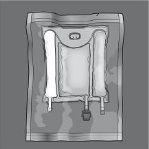

Фигура 1 Фигура 2
Подготовка смеси
- Убедитесь, что продукт находится при комнатной температуре перед разрушением непостоянных уплотнений.
- Поместите мешок на чистую и ровную поверхность.
Активация мешка из 3 камер (разрушение двух непостоянных уплотнений)
Шаг 1: Сверните мешок от стороны крюка в D
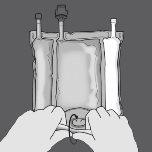
Шаг 2: Нажмите до тех пор, пока не разрушатся непостоянные уплотнения.

Шаг 3: Измените направление и сверните мешок к крюку в D до тех пор, пока уплотнение не будет полностью открыто. Повторите те же шаги, чтобы открыть второе непостоянное уплотнение.

Шаг 4: Сверните мешок не менее трех раз, чтобы хорошо смешать содержимое. Внешний вид смешанной смеси должен быть эмульсией белого цвета.
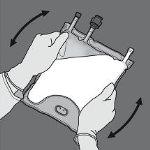
Шаг 5: Удалите защитный колпачок из точки введения и вставьте оборудование для внутривенного введения.

Активация мешка из 2 камер (разрушение непостоянного уплотнения между камерами аминокислот и глюкозы)
Шаг 1: Чтобы разрушить только непостоянное уплотнение аминокислот/глюкозы, начните сворачивать мешок от угла крюка в D от уплотнения, разделяющего камеры аминокислот и глюкозы, и нажмите, чтобы открыть уплотнение, разделяющее оба отсека.
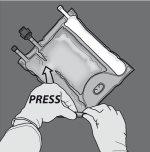
Шаг 2: Поместите мешок так, чтобы отсек с липидной эмульсией был обращен к оператору, и сверните мешок, защищая отсек с липидной эмульсией ладонями рук.
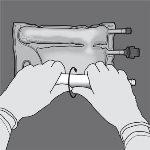
Шаг 3: Одной рукой примените давление, сворачивая мешок к трубкам.
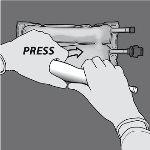
Шаг 4: Затем измените направление и сверните мешок к крюку в D, нажимая другой рукой до тех пор, пока уплотнение, разделяющее растворы аминокислот и глюкозы, не будет полностью открыто.

Шаг 5: Сверните мешок не менее трех раз, чтобы хорошо смешать содержимое. Внешний вид смешанной смеси должен быть прозрачным, бесцветным или слегка желтоватым.
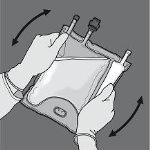
Шаг 6: Удалите защитный колпачок из точки введения и вставьте оборудование для внутривенного введения.
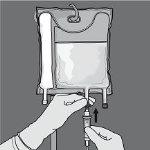
Скорость введения должна постепенно увеличиваться в течение первого часа и корректироваться в зависимости от следующих факторов:
Доза, которая будет введена
Суточное потребление объема
Продолжительность перфузии.
Способ введения
Когда используется у новорожденных и детей младше 2 лет, эмульсия (в мешке и в оборудовании для введения) должна быть защищена от воздействия света до окончания введения.
Рекомендуется использовать фильтр 1,2 мкм для введения Numeta G13%E.
Из-за высокой осмолярности Numeta G13%E можно вводить без разбавления только через центральную вену; однако соответствующее разбавление Numeta G13%E водой для инъекций снижает осмолярность и позволяет периферическую перфузию. Следующая формула показывает влияние разбавления на осмолярность мешков.
Окончательная осмолярность | = | Объем мешка х начальная осмолярность |
Добавленная вода + Объем мешка |
Следующая таблица показывает примеры осмолярности для добавок мешков 2 и 3 камер после активации и добавления воды для инъекций:
Аминокислоты и глюкоза(Активированная 2К) | Аминокислоты, глюкоза илипиды (Активированная 3К) | |
Начальный объем в мешке (мл) | 240 | 300 |
Начальная осмолярность (мОсм/л прибл) | 1400 | 1150 |
Объем добавленной воды (мл) | 240 | 300 |
Окончательный объем после добавления (мл) | 480 | 600 |
Осмолярность после добавления (мОсм/л прибл) | 700 | 575 |
Добавление лекарств
Воздействие света на растворы для парентерального питания внутривенно, особенно после смешивания с олигоэлементами или витаминами, может иметь неблагоприятные эффекты на клинический исход у новорожденных из-за образования пероксидов и других продуктов разложения. Когда используется у новорожденных и детей младше 2 лет, Numeta G13%E должен быть защищен от воздействия света до окончания введения.
Можно добавлять совместимые лекарства в реконструированную смесь (после открытия непостоянных уплотнений и смешивания содержимого двух или трех камер).
Также можно добавлять витамины в камеру глюкозы до реконструкции смеси (до открытия непостоянных уплотнений и смешивания растворов и эмульсии).
В таблицах 1-4 показаны возможные добавки коммерчески доступных растворов олигоэлементов (обозначаемых как TE1 и TE4), витаминов (обозначаемых как лиофилизированный V1 и эмульсия V2) и электролитов в определенных количествах.
1 Совместимость с TE4, V1 и V2
Таблица 1: Совместимость 3-в-1 (Активированная 3К) с или без разбавления водой
На 300 мл (смесь 3 в 1 с липидами) | ||||||
Смесь без разбавления | Смесь с разбавлением | |||||
Добавки | Уровень, включенный | Максимальное добавление | Общий максимальный уровень | Уровень, включенный | Максимальное добавление | Общий максимальный уровень |
Натрий (ммоль) | 6,6 | 5,0 | 11,6 | 6,6 | 5,0 | 11,6 |
Калий (ммоль) | 6,2 | 4,2 | 10,4 | 6,2 | 4,2 | 10,4 |
Магний (ммоль) | 0,47 | 0,83 | 1,3 | 0,47 | 0,83 | 1,3 |
Кальций (ммоль) | 3,8 | 3,5 | 7,3 | 3,8 | 3,5 | 7,3 |
Фосфат* (ммоль) | 3,8 | 2,5 | 6,3 | 3,8 | 2,5 | 6,3 |
Олигоэлементы и витамины | - | 15 мл TE4+ 1,5 флакона V1+ 25 мл V2 | 15 мл TE4+ 1,5 флакона V1+ 25 мл V2 | - | 15 мл TE4+ 1,5 флакона V1+ 25 мл V2 | 15 мл TE4+ 1,5 флакона V1+ 25 мл V2 |
Вода для инъекций | - | - | - | - | 300 мл | 300 мл |
- Фосфат органический
Таблица 2: Совместимость 2-в-1 (Активированная 2К) с или без разбавления водой
На 240 мл (смесь 2 в 1 без липидов) | ||||||
Смесь без разбавления | Смесь с разбавлением | |||||
Добавка | Уровень, включенный | Максимальное добавление | Общий максимальный уровень | Уровень, включенный | Максимальное добавление | Общий максимальный уровень |
Натрий (ммоль) | 6,4 | 17,6 | 24 | 6,4 | 0,0 | 6,4 |
Калий (ммоль) | 6,2 | 17,8 | 24 | 6,2 | 0,0 | 6,2 |
Магний (ммоль) | 0,47 | 2,13 | 2,6 | 0,47 | 0,0 | 0,47 |
Кальций (ммоль) | 3,8 | 3,5 | 7,3 | 3,8 | 0,0 | 3,8 |
Фосфат* (ммоль) | 3,2 | 4,0 | 7,2 | 3,2 | 0,0 | 3,2 |
Олигоэлементы и витамины | - | 2,5 мл TE4+ ¼ флакона V1 | 2,5 мл TE4+ ¼ флакона V1 | - | 2,5 мл TE4+ ¼ флакона V1 | 2,5 мл (¼ флакона) TE4+ ¼ флакона V1 |
Вода для инъекций | - | - | - | - | 240 мл | 240 мл |
- Фосфат органический
2 Совместимость с TE1, V1 и V2
Таблица 3: Совместимость 3-в-1 (Активированная 3К) с или без разбавления водой
На 300 мл (смесь 3 в 1 с липидами) | ||||||
Смесь без разбавления | Смесь с разбавлением | |||||
Добавки | Уровень, включенный | Максимальное добавление | Общий максимальный уровень | Уровень, включенный | Максимальное добавление | Общий максимальный уровень |
Натрий (ммоль) | 6,6 | 5,0 | 11,6 | 6,6 | 0,0 | 6,6 |
Калий (ммоль) | 6,2 | 4,2 | 10,4 | 6,2 | 0,0 | 6,2 |
Магний (ммоль) | 0,47 | 0,83 | 1,3 | 0,47 | 0,0 | 0,47 |
Кальций (ммоль) | 3,8 | 1,9 | 5,7 | 3,8 | 0,0 | 3,8 |
Фосфат* (ммоль) | 3,8 | 2,5 | 6,3 | 3,8 | 0,0 | 3,8 |
Олигоэлементы и витамины | - | 2,5 мл TE1+ ¼ флакона V1+ 2,5 мл V2 | 2,5 мл TE1+ ¼ флакона V1+ 2,5 мл V2 | - | 2,5 мл TE1+ ¼ флакона V1+ 2,5 мл V2 | 2,5 мл TE1+ ¼ флакона V1+ 2,5 мл V2 |
Вода для инъекций | - | - | - | - | 300 мл | 300 мл |
- Фосфат органический
Таблица 4: Совместимость 2-в-1 (Активированная 2К) с или без разбавления водой
На 240 мл (смесь 2 в 1 без липидов) | ||||||
Смесь без разбавления | Смесь с разбавлением | |||||
Добавки | Уровень, включенный | Максимальное добавление | Общий максимальный уровень | Уровень, включенный | Максимальное добавление | Общий максимальный уровень |
Натрий (ммоль) | 6,4 | 17,6 | 24 | 6,4 | 0,0 | 6,4 |
Калий (ммоль) | 6,2 | 17,8 | 24 | 6,2 | 0,0 | 6,2 |
Магний (ммоль) | 0,47 | 2,13 | 2,6 | 0,47 | 0,0 | 0,47 |
Кальций (ммоль) | 3,8 | 3,5 | 7,3 | 3,8 | 0,0 | 3,8 |
Фосфат* (ммоль) | 3,2 | 4,0 | 7,2 | 3,2 | 0,0 | 3,2 |
Олигоэлементы и витамины | - | 2,5 мл TE1+ ¼ флакона V1 | 2,5 мл TE1+ ¼ флакона V1 | - | 2,5 мл TE1+ ¼ флакона V1 | 2,5 мл (¼ флакона TE1+ ¼ флакона V1 |
Вода для инъекций | - | - | - | - | 240 мл | 240 мл |
- Фосфат органический
Состав витаминных и олигоэлементных препаратов показан ниже в таблицах 5 и 6:
Таблица 5: Состав коммерческого олигоэлементного препарата:
Составна флакон | TE1 (10 мл) | TE4 (10 мл) |
Цинк | 38,2 мкмоль или 2,5 мг | 15,3 мкмоль или 1 мг |
Селен | 0,253 мкмоль или 0,02 мг | 0,253 мкмоль или 0,02 мг |
Медь | 3,15 мкмоль или 0,2 мг | 3,15 мкмоль или 0,2 мг |
Йод | 0,0788 мкмоль или 0,01 мг | 0,079 мкмоль или 0,01 мг |
Фтор | 30 мкмоль или 0,57 мг | - |
Марганец | 0,182 мкмоль или 0,01 мг | 0,091 мкмоль или 0,005 мг |
Таблица 6: Состав коммерческих витаминных препаратов:
Состав на флакон | V1 | V2 |
Витамин B1 | 2,5 мг | - |
Витамин B2 | 3,6 мг | - |
Никотинамид | 40 мг | - |
Витамин B6 | 4,0 мг | - |
Пантотеновая кислота | 15,0 мг | - |
Биотин | 60 мкг | - |
Фолиевая кислота | 400 мкг | - |
Витамин B12 | 5,0 мкг | - |
Витамин C | 100 мг | - |
Витамин A | - | 2300 МЕ |
Витамин D | - | 400 МЕ |
Витамин E | - | 7 МЕ |
Витамин K | - | 200 мкг |
Для выполнения добавки:
- Это должно быть сделано в асептических условиях.
- Подготовьте точку инъекции мешка.
- Проколите точку инъекции и введите добавки с помощью иглы для инъекции или устройства для реконструкции.
- Смешайте содержимое мешка и добавки.
Подготовка перфузии:
- Это должно быть сделано в асептических условиях.
- Подвесьте мешок.
- Удалите защитный колпачок из точки введения.
- Твердamente вставьте наконечник оборудования для перфузии в точку введения.
Введение перфузии:
- Только для одноразового использования.
- Вводите продукт только после открытия непостоянных уплотнений между двумя или тремя камерами и смешивания содержимого двух или трех камер.
- Убедитесь, что эмульсия для перфузии активированного мешка из трех камер не показывает признаков разделения фаз, и что раствор для перфузии активированного мешка из двух камер не показывает признаков частиц.
- Рекомендуется использовать сразу после разрушения непостоянных уплотнений. Не следует хранить для последующей перфузии.
- Не подключайте использованный мешок.
- Рекомендуется использовать фильтр 1,2 мкм для введения Numeta G13%E.
- Не подключайте мешки в серию, чтобы избежать газовой эмболии из-за остаточного воздуха в основном мешке.
- Когда используется у новорожденных и детей младше 2 лет, должно быть защищено от воздействия света до окончания введения.
Активные вещества:
Активное вещество | B2C активированная (240 мл) | B3C активированная (300 мл) |
Отделение аминокислот | ||
Аланин | 0,75 г | 0,75 г |
Аргинин | 0,78 г | 0,78 г |
Аспарагиновая кислота | 0,56 г | 0,56 г |
Цистеин | 0,18 г | 0,18 г |
Глутаминовая кислота | 0,93 г | 0,93 г |
Глицин | 0,37 г | 0,37 г |
Гистидин | 0,35 г | 0,35 г |
Изолейцин | 0,62 г | 0,62 г |
Лейцин | 0,93 г | 0,93 г |
Лизин моногидрат (эквивалент Лизину) | 1,15 г (1,03 г) | 1,15 г (1,03 г) |
Метіонин | 0,22 г | 0,22 г |
Орнитин гидрохлорид (эквивалент Орнитину) | 0,30 г (0,23 г) | 0,30 г (0,23 г) |
Фенилаланин | 0,39 г | 0,39 г |
Пролин | 0,28 г | 0,28 г |
Серин | 0,37 г | 0,37 г |
Таурин | 0,06 г | 0,06 г |
Треонин | 0,35 г | 0,35 г |
Триптофан | 0,19 г | 0,19 г |
Тирозин | 0,07 г | 0,07 г |
Валин | 0,71 г | 0,71 г |
Ацетат калия | 0,61 г | 0,61 г |
Хлорид кальция дигидрат | 0,55 г | 0,55 г |
Ацетат магния тетрагидрат | 0,10 г | 0,10 г |
Глицерофосфат натрия гидрат | 0,98 г | 0,98 г |
Отделение глюкозы | ||
Глюкоза моногидрат (эквивалент глюкозе анидру) | 44,00 г (40,00 г) | 44,00 г (40,00 г) |
Отделение липидов | ||
Оливковое масло, рафинированное (приблизительно 80%) + соевое масло, рафинированное (приблизительно 20%) | - | 7,5 г |
B2C = мешок из 2 камер, B3C = мешок из 3 камер
Раствор/эмульсия после восстановления обеспечивает следующее:
Состав | ||||
B2C активированная | B3C активированная | |||
На единицу объема (мл) | 240 | 100 | 300 | 100 |
Азот (г) | 1,4 | 0,59 | 1,4 | 0,47 |
Аминокислоты (г) | 9,4 | 3,9 | 9,4 | 3,1 |
Глюкоза (г) | 40,0 | 16,7 | 40,0 | 13,3 |
Липиды (г) | 0 | 0 | 7,5 | 2,5 |
Энергия | ||||
Общая калорийность (ккал) | 198 | 82 | 273 | 91 |
Непротеиновая калорийность (ккал) | 160 | 67 | 235 | 78 |
Калорийность глюкозы (ккал) | 160 | 67 | 160 | 53 |
Калорийность липидов (ккал) | 0 | 0 | 75 | 25 |
Непротеиновая калорийность/азот (ккал/г N) | 113 | 113 | 165 | 165 |
Калорийность липидов (% непротеиновой калорийности) | Н/Д | Н/Д | 32 | 32 |
Калорийность липидов (% общей калорийности) | Н/Д | Н/Д | 28 | 28 |
Электролиты | ||||
Натрий (ммоль) | 6,4 | 2,7 | 6,6 | 2,2 |
Калий (ммоль) | 6,2 | 2,6 | 6,2 | 2,1 |
Магний (ммоль) | 0,47 | 0,20 | 0,47 | 0,16 |
Кальций (ммоль) | 3,8 | 1,6 | 3,8 | 1,3 |
Фосфат (ммоль) | 3,2 | 1,3 | 3,8 | 1,3 |
Ацетат (ммоль) | 7,2 | 3,0 | 7,2 | 2,4 |
Малат (ммоль) | 3,2 | 1,3 | 3,2 | 1,1 |
Хлорид (ммоль) | 9,3 | 3,9 | 9,3 | 3,1 |
pH (приблизительно) | 5,5 | 5,5 | 5,5 | 5,5 |
Осмолярность (приблизительно) (мОсм/л) | 1400 | 1400 | 1150 | 1150 |
(а) Включает калорийность фосфолипидов яичной перфузии.
(б) Включает фосфат, обеспечиваемый фосфолипидами яичной перфузии.
Остальные компоненты:
Лимонная кислота |
Соляная кислота |
Фосфолипиды яичной перфузии |
Глицерол |
Олеат натрия |
Гидроксид натрия |
Вода для инъекций |
(а) для коррекции pH
Baxter и Numeta являются зарегистрированными товарными знаками компании Baxter International Inc.
- Страна регистрации
- Активное вещество
- Требуется рецептДа
- Производитель
- Информация носит справочный характер и не является медицинской рекомендацией. Перед приемом любых препаратов проконсультируйтесь с врачом. Oladoctor не несет ответственности за медицинские решения, принятые на основе этого контента.
- Аналоги НУМЕТА G13% Эмульсия для инфузийФорма выпуска: ИНФУЗИОННЫЙ РАСТВОР ДЛЯ ИНЪЕКЦИЙ, 3,92 г / 1,26 г / 7,21 г / 3,36 г / 4,2 г / 5,11 г / 2,94 г / 2,8 г / 4,76 г / 5,07 г / 4,06 г / 14,49 г / 0,28 г / 8,05 г / 3,5 г / 200 гАктивное вещество: combinationsПроизводитель: Baxter S.L.Требуется рецептФорма выпуска: ИНФУЗИОННЫЙ РАСТВОР ДЛЯ ИНЪЕКЦИЙ, 3,5 г / 200 г / 5,22 г / 1,88 г / 3,92 г / 1,26 г / 7,21 г / 3,36 г / 4,2 г / 5,11 г / 2,94 г / 2,8 г / 662 мг / 1,02 г / 4,76 г / 5,15 г / 5,07 г / 4,06 г / 14,49 г / 0,28 г / 8,05 гАктивное вещество: combinationsПроизводитель: Baxter S.L.Требуется рецептФорма выпуска: ИНФУЗИОННЫЙ РАСТВОР ДЛЯ ИНЪЕКЦИЙ, 4,25 г / 300 г / 5,22 г / 1,54 г / 4,76 г / 1,53 г / 8,76 г / 4,08 г / 5,1 г / 6,2 г / 3,57 г / 3,4 г / 662 мг / 1,02 г / 5,78 г / 5,94 г / 6,16 г / 4,93 г / 17,6 г / 0,34 г / 9,78 гАктивное вещество: combinationsПроизводитель: Baxter S.L.Требуется рецепт
Аналоги НУМЕТА G13% Эмульсия для инфузий в других странах
Лучшие аналоги с тем же действующим веществом и терапевтическим эффектом.
Аналог НУМЕТА G13% Эмульсия для инфузий в Польша
Аналог НУМЕТА G13% Эмульсия для инфузий в Украина
Врачи онлайн по НУМЕТА G13% Эмульсия для инфузий
Консультация по дозировке, побочным эффектам, взаимодействиям, противопоказаниям и продлению рецепта на НУМЕТА G13% Эмульсия для инфузий – по решению врача и с учетом местных правил.














